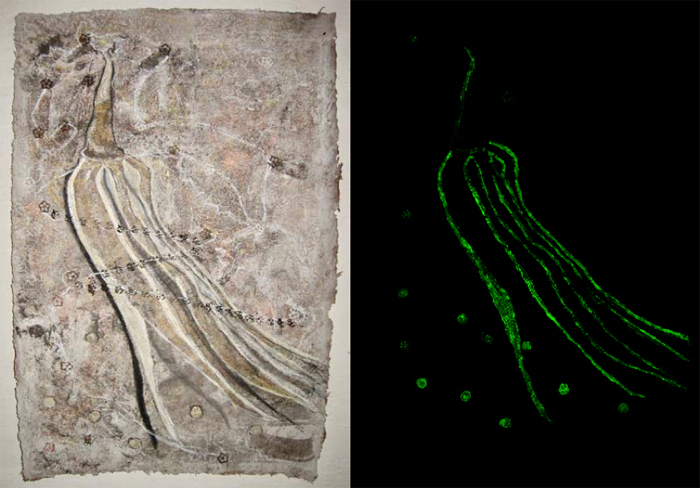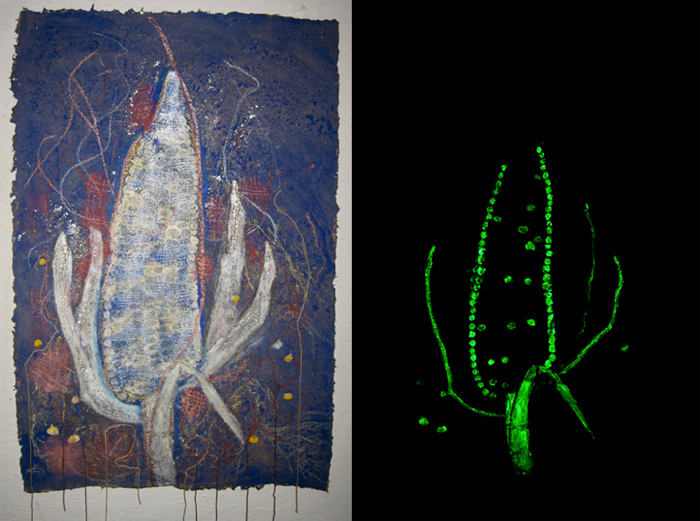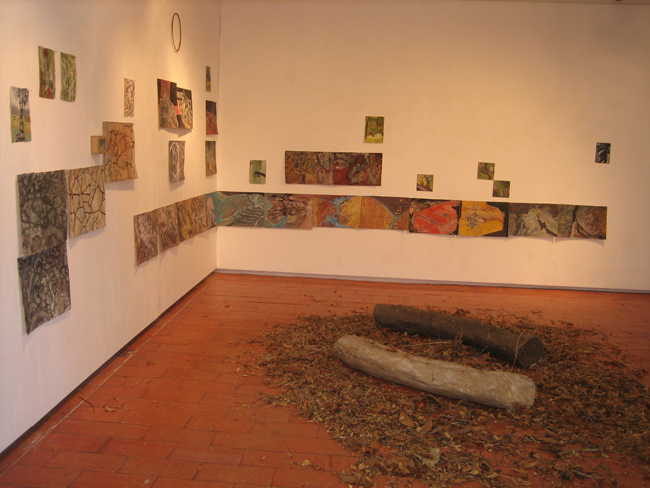olhos fechados / memorias diarias
Randee Silv
April 2020
In conversation with Catherine Henke
Your recent exhibition at the Galeria Municipal de Montemor-o-Novo is titled “olhos fechados / memorias diarias / eyes closed / daily memories”. What are you referencing? Suggesting? Evoking?
The title evokes memory and the double gaze. I can see the objects that are familiar to me, with open eyes, and with eyes closed, in light, and in dark (and the results are not the same). Everyday I see the world around me, by day and by night, and they’re quite different. But, in any case, I can perceive both simultaneously.
Could you give some examples of how this works? How does this dual perception come to you?
Every day, we see with light or without. For example, the sky during the day is blue or with clouds. During the night, it is dark or with stars. A city in the daylight is different from a city at night. It’s unusual to visit an exhibition of paintings in the dark. With light, you can see the paintings, their colors and textures. There are some structural sections where I have used fluorescent paint, perfectly integrated into the painting to be seen in the light, and, in the dark, only these areas appear. It creates an amazing effect and a completely different space. This dual perception came to me in previous work, from which resulted another exhibition, SPORES. There, the dual perception was the recto and verso, expressing that the same object can be seen from different positions. My son, who is working in the same studio as I, is frequently using fluorescent paint in both his artwork and in clothing, and I just felt like I wanted to try it, and there was the double gaze again.
How are you able to show the glow of the fluorescent paint? Do the viewers actually find themselves standing in the dark? Do you feel you’ve been able to capture the visual experience of the double gaze?
The big room is lit, which activates the fluorescent paint. Sometimes we turn off the light and the room is dark. With the lights on, we can see the paintings with all their colors and textures. When we turn off the lights, it’s totally dark and yes, the viewers are standing in the dark and we just hear “oooaahhh”. We then see the paintings more as a structure of light (no color, no texture, just light and space, like the stars in the sky by night). They are the same paintings, but they look totally different.
Structures of light. Yes, I can imagine how each painting radiates its own essence. I read in the exhibition catalog that you have “developed knowledge related to the rhythms of nature and to an ecological consciousness”. Can you talk more about these connections.
Living in the country, being a lot outside, and practicing organic agriculture, I turn myself more towards the rhythms of nature. These pieces that I’ve painted are some kind of frontal portraits of objects with which I’m in contact most of the time, at some periods of the year.
Each painting is like a close-up, intricate and detailed. You can really feel their presence. Your color palette is very striking. There’s a sense of mood, a dialogue with what you are seeing. What inspired you to paint these objects as portraits? And where to place the fluorescent paint?
I’ve been blocked with my work for sometime, because of personal life’s problems. I got these marvelous papers and the paper was so attractive to me that suddenly everything flew naturally without thinking about anything. It was like water that has been stuck for awhile and suddenly released. I just let it go until it stopped. I didn’t have the feeling of deciding anything, it was all very intuitive.
I can see from the images you sent, that there is a room where these portraits are displayed, and then I see a corner area with different groupings of paintings and pieces of trees and scattered leaves. Everything is so interestingly positioned. Tell us about this installation.
Yes, there is a large room with the portraits of the objects and a smaller one with an installation called, Landscape. Where the corners of the two walls meet, there’s a series of paintings to show different visions of the earth with some little paintings growing from the main strip. On the floor, there are 2 paper trees and scattered leaves. For me it’s just a way of drawing a landscape.
You mentioned earlier that this exhibition evolved from your last one, Spores. Both exhibitions address other ways of engaging with landscape and how objects can be seen very many perspectives. Each person, of course, will have their own encounter, but if we see these paintings as prompts, triggers to the awareness of the double gaze, what ideas, thoughts, would you like the viewers to leave with?
Yes, I mentioned that this exhibition evolved from the last one, “Spores”. But it was not the idea in the beginning, it was an unconscious process and I just realized that it was the evolution from the other one when I started to work with the fluorescent paint and again with this process of the double gaze. I don’t feel that I want to provoke any special feelings or experiences for the viewers. I just feel that I’ve got to follow my own search and experience, and if anyone is touched by these paintings, it’s nice. Actually, most of the public has loved the exhibition. One friend said to me, “what amazes me the most in some kind of work is to observe that people practice art for such centuries and it continues to appear new forms, new works that we don’t expect” and I would add that even the artist doesn’t control it, it just appears spontaneously, because it’s the right time. And this is the magic!
Images courtesy of the artist and Tiago Fróis Dias Silva
Read the interview with Catherine Henke on her exhibition
esporos/spores →
Catherine Henke, a visual artist originally from Geneva, Switzerland who lives and works in Montemor-o-Novo, Portugal. This radical change in her living conditions encouraged her to learn about rural life and the practice of organic agriculture. She has developed knowledge related to the rhythms of nature and to an ecological consciousness. Her art practice comprises varying uses of numerous techniques, such as painting, sculpture, ceramic and mixed media installation.







